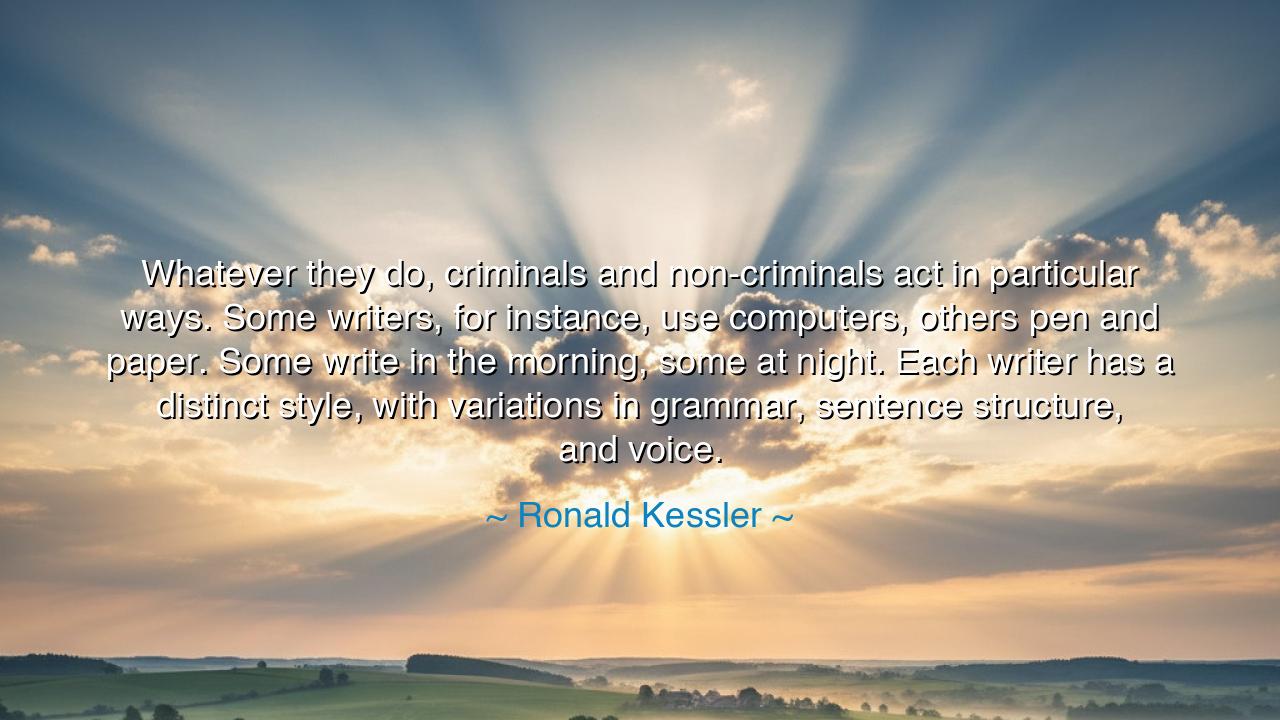
Whatever they do, criminals and non-criminals act in particular
Whatever they do, criminals and non-criminals act in particular ways. Some writers, for instance, use computers, others pen and paper. Some write in the morning, some at night. Each writer has a distinct style, with variations in grammar, sentence structure, and voice.






In the discerning and timeless words of Ronald Kessler, we are given a glimpse into one of the oldest truths about human nature: “Whatever they do, criminals and non-criminals act in particular ways. Some writers, for instance, use computers, others pen and paper. Some write in the morning, some at night. Each writer has a distinct style, with variations in grammar, sentence structure, and voice.” These words, though spoken in the context of crime and investigation, rise far above their immediate subject. They remind us that every human being, whether saint or sinner, leaves behind a pattern, a mark that reveals the soul behind the act. For in every motion of the hand, in every word, in every choice — there is identity.
From the days of the ancients, wise observers understood that character is revealed through habit. The Greeks spoke of ethos — the enduring moral and behavioral essence of a person — and the Chinese sages taught that one’s inner nature can be known through the smallest gestures. Kessler’s insight continues this lineage: that even in an age of machines, where we type instead of carve and click instead of craft, our individuality still shines through. Whether a person writes with a pen or a keyboard, their inner rhythm manifests — in phrasing, in word choice, in cadence. It is the fingerprint of the mind, invisible yet inescapable.
The origin of this quote lies in Kessler’s long career as a journalist and investigator, a man who spent decades studying both the noble and the corrupt. In his writings on intelligence agencies and criminal behavior, he observed that the smallest details — the tone of an email, the phrasing of a threat, the structure of a sentence — could reveal the hidden hand behind it. In the digital age, investigators use what is called stylometry — the art of identifying a person’s unique writing style — to unmask criminals who believe anonymity shields them. Yet beyond forensics, Kessler’s observation becomes a meditation on the nature of individuality: no one can fully disguise who they are, for even their attempts at disguise carry their signature.
Consider the tale of the anonymous “Unabomber,” whose identity remained hidden for nearly two decades. He sent letters, he built bombs, he wrote manifestos. The world knew his actions, but not his name. Yet in the end, it was not fingerprints or witnesses that revealed him, but his writing. His brother recognized the pattern of words — the rhythm of his thoughts — and knew the man behind the mask. So it has always been: even in darkness, a person’s nature reveals itself through the trace of their hand, the style of their voice, the pattern of their thought.
Kessler’s words thus remind us of a profound and humbling truth: we cannot escape ourselves. Every action, no matter how small, bears our signature. The way we speak, the way we write, even the way we think, all flow from the unique river of our being. Whether one builds or destroys, creates or corrupts, the style remains consistent. Just as a tree is known by its fruit, a human being is known by the pattern of their deeds. It is not the mask that defines a person, but the habits that lie beneath it.
Yet in this truth lies also a call to wisdom and self-awareness. If our actions reveal who we are, then let them reveal what is noble, compassionate, and true. The ancients urged their disciples to “know thyself,” not merely as a philosophical exercise, but as a moral imperative. For only by knowing our tendencies — our rhythms, our “distinct style” — can we refine them. Just as the craftsman perfects his art through practice, so too must the soul shape its habits through mindfulness and integrity. In knowing the patterns we leave behind, we gain the power to change them.
Let this, then, be the teaching passed to future generations: your life is your handwriting upon the world. Every word you speak, every deed you perform, every decision you make becomes part of your signature in the great book of existence. Be mindful, for what you write cannot be erased easily. Strive that your pattern — your style, your voice — becomes one of kindness, courage, and honesty. For as Ronald Kessler reminds us, whether in art, in work, or in wrongdoing, each of us reveals ourselves through our ways.
And so, O seeker of truth, remember: you may hide your face, but not your essence. You may change your tools, but not your nature. Whether by pen or computer, by speech or silence, by action or inaction — your true self leaves its mark. Make that mark worthy. Let your habits sing of wisdom, your words echo with compassion, and your legacy be the reflection of a life well lived.






AAdministratorAdministrator
Welcome, honored guests. Please leave a comment, we will respond soon